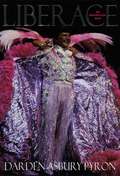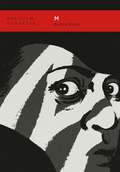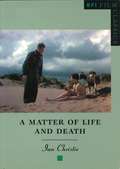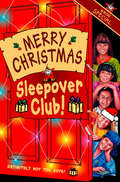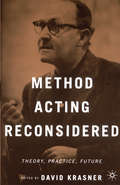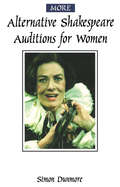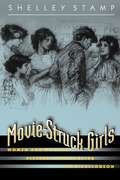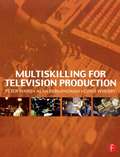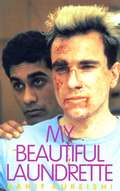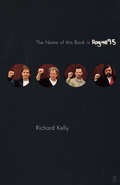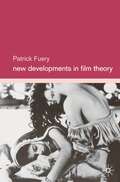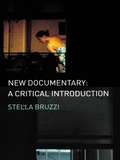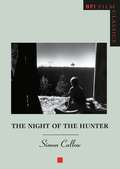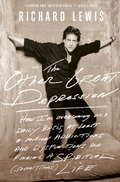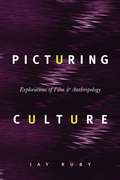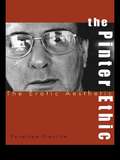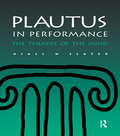- Table View
- List View
Liberace: An American Boy
by Darden Asbury PyronMore people watched his nationally syndicated television show between 1953 and 1955 than followed I Love Lucy. Even a decade after his death, the attendance records he set at Madison Square Garden, the Hollywood Bowl, and Radio City Music Hall still stand. Arguably the most popular entertainer of the twentieth century, this very public figure nonetheless kept more than a few secrets. Darden Asbury Pyron, author of the acclaimed and bestselling Southern Daughter: The Life of Margaret Mitchell, leads us through the life of America's foremost showman with his fresh, provocative, and definitive portrait of Liberace, an American boy. Liberace's career follows the trajectory of the classic American dream. Born in the Midwest to Polish-Italian immigrant parents, he was a child prodigy who, by the age of twenty, had performed with the Chicago Symphony Orchestra. Abandoning the concert stage for the lucrative and glittery world of nightclubs, celebrities, and television, Liberace became America's most popular entertainer. While wildly successful and good natured outwardly, Liberace, Pyron reveals, was a complicated man whose political, social, and religious conservativism existed side-by-side with a lifetime of secretive homosexuality. Even so, his swishy persona belied an inner life of ferocious aggression and ambition. Pyron relates this private man to his public persona and places this remarkable life in the rapidly changing cultural landscape of twentieth-century America. Pyron presents Liberace's life as a metaphor, for both good and ill, of American culture, with its shopping malls and insatiable hunger for celebrity. In this fascinating biography, Pyron complicates and celebrates our image of the man for whom the streets were paved with gold lamé. "An entertaining and rewarding biography of the pianist and entertainer whose fans' adoration was equaled only by his critics' loathing. . . . [Pyron] persuasively argues that Liberace, thoroughly and rigorously trained, was a genuine musician as well as a brilliant showman. . . . [A]n immensely entertaining story that should be fascinating and pleasurable to anyone with an interest in American popular culture."—Kirkus Reviews "This is a wonderful book, what biography ought to be and so seldom is."—Kathryn Hughes, Daily Telegraph "[A]bsorbing and insightful. . . . Pyron's interests are far-ranging and illuminating-from the influence of a Roman Catholic sensibility on Liberace and gay culture to the aesthetics of television and the social importance of self-improvement books in the 1950s. Finally, he achieves what many readers might consider impossible: a persuasive case for Liberace's life and times as the embodiment of an important cultural moment."—Publishers Weekly "Liberace, coming on top of his amazing life of Margaret Mitchell, Southern Daughter, puts Darden Pyron in the very first rank of American biographers. His books are as exciting as the lives of his subjects."—Tom Wolfe "Fascinating, thoughtful, exhaustive, and well-written, this book will serve as the standard biography of a complex icon of American popular culture."—Library Journal
Liberace: An American Boy
by Darden Asbury PyronMore people watched his nationally syndicated television show between 1953 and 1955 than followed I Love Lucy. Even a decade after his death, the attendance records he set at Madison Square Garden, the Hollywood Bowl, and Radio City Music Hall still stand. Arguably the most popular entertainer of the twentieth century, this very public figure nonetheless kept more than a few secrets. Darden Asbury Pyron, author of the acclaimed and bestselling Southern Daughter: The Life of Margaret Mitchell, leads us through the life of America's foremost showman with his fresh, provocative, and definitive portrait of Liberace, an American boy. Liberace's career follows the trajectory of the classic American dream. Born in the Midwest to Polish-Italian immigrant parents, he was a child prodigy who, by the age of twenty, had performed with the Chicago Symphony Orchestra. Abandoning the concert stage for the lucrative and glittery world of nightclubs, celebrities, and television, Liberace became America's most popular entertainer. While wildly successful and good natured outwardly, Liberace, Pyron reveals, was a complicated man whose political, social, and religious conservativism existed side-by-side with a lifetime of secretive homosexuality. Even so, his swishy persona belied an inner life of ferocious aggression and ambition. Pyron relates this private man to his public persona and places this remarkable life in the rapidly changing cultural landscape of twentieth-century America. Pyron presents Liberace's life as a metaphor, for both good and ill, of American culture, with its shopping malls and insatiable hunger for celebrity. In this fascinating biography, Pyron complicates and celebrates our image of the man for whom the streets were paved with gold lamé. "An entertaining and rewarding biography of the pianist and entertainer whose fans' adoration was equaled only by his critics' loathing. . . . [Pyron] persuasively argues that Liberace, thoroughly and rigorously trained, was a genuine musician as well as a brilliant showman. . . . [A]n immensely entertaining story that should be fascinating and pleasurable to anyone with an interest in American popular culture."—Kirkus Reviews "This is a wonderful book, what biography ought to be and so seldom is."—Kathryn Hughes, Daily Telegraph "[A]bsorbing and insightful. . . . Pyron's interests are far-ranging and illuminating-from the influence of a Roman Catholic sensibility on Liberace and gay culture to the aesthetics of television and the social importance of self-improvement books in the 1950s. Finally, he achieves what many readers might consider impossible: a persuasive case for Liberace's life and times as the embodiment of an important cultural moment."—Publishers Weekly "Liberace, coming on top of his amazing life of Margaret Mitchell, Southern Daughter, puts Darden Pyron in the very first rank of American biographers. His books are as exciting as the lives of his subjects."—Tom Wolfe "Fascinating, thoughtful, exhaustive, and well-written, this book will serve as the standard biography of a complex icon of American popular culture."—Library Journal
Liberace: An American Boy
by Darden Asbury PyronMore people watched his nationally syndicated television show between 1953 and 1955 than followed I Love Lucy. Even a decade after his death, the attendance records he set at Madison Square Garden, the Hollywood Bowl, and Radio City Music Hall still stand. Arguably the most popular entertainer of the twentieth century, this very public figure nonetheless kept more than a few secrets. Darden Asbury Pyron, author of the acclaimed and bestselling Southern Daughter: The Life of Margaret Mitchell, leads us through the life of America's foremost showman with his fresh, provocative, and definitive portrait of Liberace, an American boy. Liberace's career follows the trajectory of the classic American dream. Born in the Midwest to Polish-Italian immigrant parents, he was a child prodigy who, by the age of twenty, had performed with the Chicago Symphony Orchestra. Abandoning the concert stage for the lucrative and glittery world of nightclubs, celebrities, and television, Liberace became America's most popular entertainer. While wildly successful and good natured outwardly, Liberace, Pyron reveals, was a complicated man whose political, social, and religious conservativism existed side-by-side with a lifetime of secretive homosexuality. Even so, his swishy persona belied an inner life of ferocious aggression and ambition. Pyron relates this private man to his public persona and places this remarkable life in the rapidly changing cultural landscape of twentieth-century America. Pyron presents Liberace's life as a metaphor, for both good and ill, of American culture, with its shopping malls and insatiable hunger for celebrity. In this fascinating biography, Pyron complicates and celebrates our image of the man for whom the streets were paved with gold lamé. "An entertaining and rewarding biography of the pianist and entertainer whose fans' adoration was equaled only by his critics' loathing. . . . [Pyron] persuasively argues that Liberace, thoroughly and rigorously trained, was a genuine musician as well as a brilliant showman. . . . [A]n immensely entertaining story that should be fascinating and pleasurable to anyone with an interest in American popular culture."—Kirkus Reviews "This is a wonderful book, what biography ought to be and so seldom is."—Kathryn Hughes, Daily Telegraph "[A]bsorbing and insightful. . . . Pyron's interests are far-ranging and illuminating-from the influence of a Roman Catholic sensibility on Liberace and gay culture to the aesthetics of television and the social importance of self-improvement books in the 1950s. Finally, he achieves what many readers might consider impossible: a persuasive case for Liberace's life and times as the embodiment of an important cultural moment."—Publishers Weekly "Liberace, coming on top of his amazing life of Margaret Mitchell, Southern Daughter, puts Darden Pyron in the very first rank of American biographers. His books are as exciting as the lives of his subjects."—Tom Wolfe "Fascinating, thoughtful, exhaustive, and well-written, this book will serve as the standard biography of a complex icon of American popular culture."—Library Journal
M (BFI Film Classics)
by Anton KaesFritz Lang's 'M' (1931) is an undisputed classic of world cinema. Lang considered it his most lasting work. Peter Lorre's extraordinary performance as the childlike misfit Hans Beckert was one of the most striking of film debuts, and it made him an international star. Lang's vision of a city gripped with fear, haunted by surveillance and total mobillization, is still remarkably powerful today. And 'M' resonates too in the serial-killer genre which is so prominent in contemporary cinema. 'M' speaks to us as a timeless classic, but also as a Weimar film that has too often been isolated from its political and cultural context. In this groundbreaking book, Anton Kaes reconnects 'M''s much-studied formal brilliance to its significance as an event in 1931 Germany, recapturing the film's extraordinary social and symbolic energy. Interweaving close reading with cultural history, Kaes reconstitutes 'M' as a crucial modernist artwork. In addition he analyzes Joseph Losey's 1951 film noir remake and, in an appendix, publishes for the first time 'M''s missing scene.
A Matter of Life and Death (BFI Film Classics)
by Ian ChristieA dazzling fantasy produced in the aftermath of World War Two, A Matter of Life and Death (1946), directed by Michael Powell and Emeric Pressburger, starred David Niven as an RAF pilot poised between life and death. This books looks in detail at the making of the film. Ian Christie shows how the film drew on many sources and traditions to create a unique form of modern masque, treating contemporary issues with witty allegory and enormous visual imagination. He believes the film deserves to be thought of as one of cinema's greatest achievement.
Merry Christmas, Sleepover Club: Christmas Special (The Sleepover Club #36)
by Sue MongredienJoin the Sleepover Club: Frankie, Kenny, Felicity, Rosie and Lyndsey, five girls who want to have fun – but who always end up in mischief!
Method Acting Reconsidered: Theory, Practice, Future
by NA NAMethod Acting is one of the most popular and controversial approaches to acting in the United States. It has not only shaped important schools of acting, but has been a fundamental constant of all American acting. This insightful volume explores Method Acting from a broad perspective, focusing on a point of equilibrium between the principles of the Method and its relationship to other theories of performance. David Krasner has gathered together some of the most well-known theater scholars and acting teachers to look at the Method. By concentrating on three areas of the Method - its theory, practice, and future application - the collection will serve to inform and teach us how to approach acting and acting theory in the 21st century.
More Alternative Shakespeare Auditions for Women
by Simon DunmoreFollowing on his successful Alternative Shakespeare Auditions for Women, Simon Dunmore presents even more underappreciated speeches that will make a classical audition sound fresh.
More Alternative Shakespeare Auditions for Women
by Simon DunmoreFollowing on his successful Alternative Shakespeare Auditions for Women, Simon Dunmore presents even more underappreciated speeches that will make a classical audition sound fresh.
Movie-Struck Girls: Women and Motion Picture Culture after the Nickelodeon
by Shelley StampMovie-Struck Girls examines women's films and filmgoing in the 1910s, a period when female patronage was energetically courted by the industry for the first time. By looking closely at how women were invited to participate in movie culture, the films they were offered, and the visual pleasures they enjoyed, Shelley Stamp demonstrates that women significantly complicated cinemagoing throughout this formative, transitional era. Growing female patronage and increased emphasis on women's subject matter did not necessarily bolster cinema's cultural legitimacy, as many in the industry had hoped, for women were not always enticed to the cinema by dignified, uplifting material, and once there, they were not always seamlessly integrated in the social space of theaters, nor the new optical pleasures of film viewing. In fact, Stamp argues that much about women's films and filmgoing in the postnickelodeon years challenged, rather than served, the industry's drive for greater respectability. White slave films, action-adventure serial dramas, and women's suffrage photoplays all drew female audiences to the cinema with stories aimed directly at women's interests and with advertising campaigns that specifically targeted female moviegoers. Yet these examples suggest that women's patronage was built with stories focused on sexuality, sensational thrill-seeking, and feminist agitation, topics not normally associated with ladylike gentility. And in each case concerns were raised about women's conduct at cinemas and the viewing habits they enjoyed, demonstrating that women's integration into motion picture culture was not as smooth as many have thought.
Movie-Struck Girls: Women and Motion Picture Culture after the Nickelodeon (PDF)
by Shelley StampMovie-Struck Girls examines women's films and filmgoing in the 1910s, a period when female patronage was energetically courted by the industry for the first time. By looking closely at how women were invited to participate in movie culture, the films they were offered, and the visual pleasures they enjoyed, Shelley Stamp demonstrates that women significantly complicated cinemagoing throughout this formative, transitional era. Growing female patronage and increased emphasis on women's subject matter did not necessarily bolster cinema's cultural legitimacy, as many in the industry had hoped, for women were not always enticed to the cinema by dignified, uplifting material, and once there, they were not always seamlessly integrated in the social space of theaters, nor the new optical pleasures of film viewing. In fact, Stamp argues that much about women's films and filmgoing in the postnickelodeon years challenged, rather than served, the industry's drive for greater respectability. White slave films, action-adventure serial dramas, and women's suffrage photoplays all drew female audiences to the cinema with stories aimed directly at women's interests and with advertising campaigns that specifically targeted female moviegoers. Yet these examples suggest that women's patronage was built with stories focused on sexuality, sensational thrill-seeking, and feminist agitation, topics not normally associated with ladylike gentility. And in each case concerns were raised about women's conduct at cinemas and the viewing habits they enjoyed, demonstrating that women's integration into motion picture culture was not as smooth as many have thought.
Multiskilling for Television Production
by Peter Ward Alan Bermingham Chris WherryWritten by television trainers who run their own courses on Multiskilling, this book offers a comprehensive introduction to the broad range of skills and technical knowledge required in this industry. It details all the essential information you need to know, acting as an on-the-job reference source for everyday use. For many broadcasting technicians, one of the biggest challenges in recent years has been the transition from a career working in a solo core skill such as camerawork or audio, to acquiring the experience and expertise of a range of production jobs. Many people are expected to work in a number of crafts and to equip themselves with a much wider range of television techniques than had been customary in the past.Multiskilling has become an integral part of television culture, requiring that new entrants are competent in several specialist production skills. Multiskilling for Television Production concentrates on the techniques associated with news and magazine programme production, where most tecnhical operators are usually employed, but most techniques are shared across the whole spectrum of television and film making.Anyone baffled by the range and scope of skills to be mastered will find this book invaluable.
Multiskilling for Television Production
by Peter Ward Alan Bermingham Chris WherryWritten by television trainers who run their own courses on Multiskilling, this book offers a comprehensive introduction to the broad range of skills and technical knowledge required in this industry. It details all the essential information you need to know, acting as an on-the-job reference source for everyday use. For many broadcasting technicians, one of the biggest challenges in recent years has been the transition from a career working in a solo core skill such as camerawork or audio, to acquiring the experience and expertise of a range of production jobs. Many people are expected to work in a number of crafts and to equip themselves with a much wider range of television techniques than had been customary in the past.Multiskilling has become an integral part of television culture, requiring that new entrants are competent in several specialist production skills. Multiskilling for Television Production concentrates on the techniques associated with news and magazine programme production, where most tecnhical operators are usually employed, but most techniques are shared across the whole spectrum of television and film making.Anyone baffled by the range and scope of skills to be mastered will find this book invaluable.
My Beautiful Laundrette: My Beautiful Laundrette; Sammy And Rosie Get Laid; London Kills Me; My Son The Fanatic
by Hanif KureishiOmar is a restless young Asian man, caring for his alcoholic father in the hustling London of the mid-1980s. His uncle, a keen Thatcherite, offers Omar an entrepreneurial opportunity to revamp a dingy laundrette, and ambitious Omar rolls up his sleeves, enlisting the assistance of his old school-friend Johnny, who has since fallen in with a gang of neo-fascists. Omar and Johnny soon form an unlikely alliance that leads to business success, as well as other, more intimate surprises.
The Name of this Book is Dogme95
by Richard T. KellyA spectre is haunting world cinema - the spectre of a Danish 'new wave' led by mercurial director Lars Von Trier. In 1995, when Von Trier and three comrades issued a 10-point 'Vow of Chastity' for the making of simpler, more truthful movies, cynics in the film business refused to take it seriously. Five years on, the international success of the raw, uncompromising 'Dogme95' films - Festen, The Idiots, Mifune, The King is Alive - has fired a volley of shots across the bows of a staid and bloated industry. Richard Kelly's investigation of the Dogme95 movement is a piece of 'gonzo journalism' in which Kelly sallies forth in search of the Dogme brothers and their accomplices, seeking to hammer out the truth from the lies in this austere and anarchic piece of cinematic mischief.
New Developments in Film Theory
by Patrick FueryThis book examines some of the most significant recent developments in film and critical theory. The book is divided into four sections, each dealing with established and alternative critical concepts and approaches. These four are: The Gaze and Subjectivity; Film and Discourse; Film and Culture; Film and Meaning. Each of these topics is explored using concepts from post-structuralism and postmodernism, working towards the idea that the relationship between film studies and critical theory is a vital and diverse interplay of rich and exciting ideas.
New Documentary: A Critical Introduction
by Stella BruzziNew Documentary: A Critical Introduction provides a comprehensive account of the last two decades of documentary filmmaking in Britain, the US and Europe. Stella Bruzzi's engaging textbook discusses key genres, filmmakers, and issues for the study of non-fiction film and television, including:* key texts such as the Zapruder film of Kennedy's assassination, Shoah, Hoop Dreams and Michael Apted's 7 Up series* documentary genres, from current affairs programming to 'fly on the wall' documentaries to 'reality tv' series* the work of documentary filmmakers such as Emile de Antonio, Fred Wiseman, Nick Broomfield, Molly Dineen and Paul Watson* the work of avant-garde filmmakers such as Chris Marker, Patrick Keiller, Peter Greenaway and Wim Wenders, whose films challenge conventions of documentary filmmaking* movies based on historical events, such as 'JFK' and 'Nixon'* faux documentaries such as This is Spinal Tap, Bob Roberts and Man Bites Dog* gender identity, queer theory, performance, 'race' and spectatorship.Bruzzi shows how theories of documentary filmmaking can be applied to contemporary texts and genres, and discusses the relationship between recent, innovative examples of the genre and the more established canon of documentary.
New Documentary: A Critical Introduction
by Stella BruzziNew Documentary: A Critical Introduction provides a comprehensive account of the last two decades of documentary filmmaking in Britain, the US and Europe. Stella Bruzzi's engaging textbook discusses key genres, filmmakers, and issues for the study of non-fiction film and television, including:* key texts such as the Zapruder film of Kennedy's assassination, Shoah, Hoop Dreams and Michael Apted's 7 Up series* documentary genres, from current affairs programming to 'fly on the wall' documentaries to 'reality tv' series* the work of documentary filmmakers such as Emile de Antonio, Fred Wiseman, Nick Broomfield, Molly Dineen and Paul Watson* the work of avant-garde filmmakers such as Chris Marker, Patrick Keiller, Peter Greenaway and Wim Wenders, whose films challenge conventions of documentary filmmaking* movies based on historical events, such as 'JFK' and 'Nixon'* faux documentaries such as This is Spinal Tap, Bob Roberts and Man Bites Dog* gender identity, queer theory, performance, 'race' and spectatorship.Bruzzi shows how theories of documentary filmmaking can be applied to contemporary texts and genres, and discusses the relationship between recent, innovative examples of the genre and the more established canon of documentary.
The Night of the Hunter (BFI Film Classics #Vol. 59)
by Simon CallowThis is an examination of 'The Night of the Hunter', Charles Laughton's only outing as a film director. It looks at the symbolism of the piece, at Willa, her throat cut sitting in the Model-T Ford, and the Preacher, a silhouetted threat on the horizon.
The Other Great Depression: How I'm overcoming, on a daily basis, at least a million addictions and disfunctions and finding a s
by Richard LewisAt the age of 44, renowned comedian Richard Lewis found himself on a gurney in the ER, toxic with alcohol, and hallucinating from excess cocaine use. The same neuroses and dysfunctions that had been the basis for his successful stage persona and inspired his best material had, it seemed, turned on him. How he got there, how he finally got on the road to recovery, and how he copes with being Richard Lewis sober on a daily basis are the subjects of this very funny, deeply honest, inspiring, but very untreacly book. USA Today called it "candid and inspirational.... A journey through Lewis' personal Inferno to eventual salvation."
Picturing Culture: Explorations of Film and Anthropology
by Jay RubyHere, Jay Ruby—a founder of visual anthropology—distills his thirty-year exploration of the relationship of film and anthropology. Spurred by a conviction that the ideal of an anthropological cinema has not even remotely begun to be realized, Ruby argues that ethnographic filmmakers should generate a set of critical standards analogous to those for written ethnographies. Cinematic artistry and the desire to entertain, he argues, can eclipse the original intention, which is to provide an anthropological representation of the subjects. The book begins with analyses of key filmmakers (Robert Flaherty, Robert Garner, and Tim Asch) who have striven to generate profound statements about human behavior on film. Ruby then discusses the idea of research film, Eric Michaels and indigenous media, the ethics of representation, the nature of ethnography, anthropological knowledge, and film and lays the groundwork for a critical approach to the field that borrows selectively from film, communication, media, and cultural studies. Witty and original, yet intensely theoretical, this collection is a major contribution to the field of visual anthropology.
The Pinter Ethic: The Erotic Aesthetic (Studies in Modern Drama)
by Penelope PrenticeFirst published in 2000. Routledge is an imprint of Taylor & Francis, an informa company.
The Pinter Ethic: The Erotic Aesthetic (Studies in Modern Drama #Vol. 2237)
by Penelope PrenticeFirst published in 2000. Routledge is an imprint of Taylor & Francis, an informa company.
Plautus in Performance: The Theatre of the Mind (Greek And Roman Theatre Archive Ser. #Vol. 2.)
by Niall W. SlaterPlautus was Ancient Rome's greatest comic playwright, Shakespeare drew heavily on his plots, and his legacy is prevalent throughout modern drama. In this expanded edition of his successful book, one of America's foremost Classical scholars introduces performance criticism to the study of Plautus' ancient drama. In addition to the original detailed studies of six of the dramatists's plays, the methodology of performance criticism, the use of conventions, and the nature of comic heroism in Plautus, this edition includes new studies on: * the induction into the world of the play * the scripted imitation of improvisation * Plautus's comments on his previous work * the nature of 'tragicomedy'.
Plautus in Performance: The Theatre of the Mind
by Niall W. SlaterPlautus was Ancient Rome's greatest comic playwright, Shakespeare drew heavily on his plots, and his legacy is prevalent throughout modern drama. In this expanded edition of his successful book, one of America's foremost Classical scholars introduces performance criticism to the study of Plautus' ancient drama. In addition to the original detailed studies of six of the dramatists's plays, the methodology of performance criticism, the use of conventions, and the nature of comic heroism in Plautus, this edition includes new studies on: * the induction into the world of the play * the scripted imitation of improvisation * Plautus's comments on his previous work * the nature of 'tragicomedy'.
